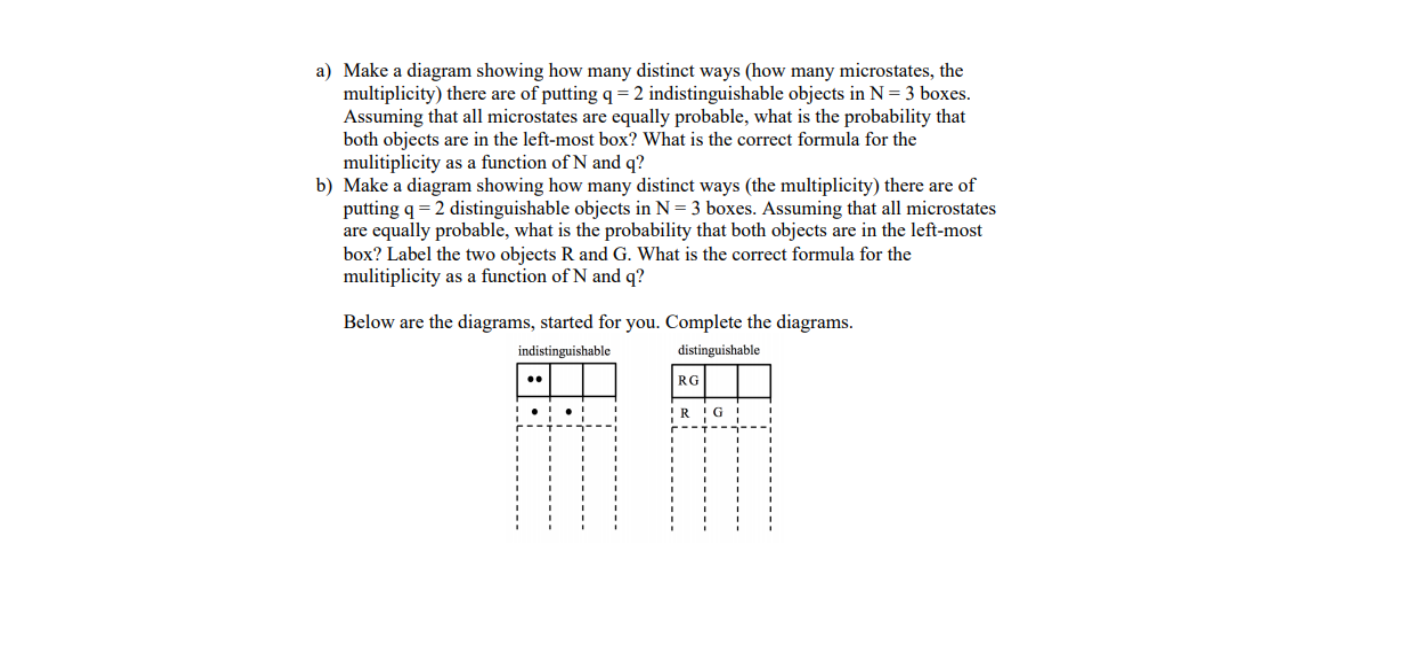a) Make a diagram showing how many distinct ways (how many microstates, the multiplicity) there are of putting q = 2 indistinguishable objects in N = 3 boxes. Assuming that all microstates are equally probable, what is the probability that both objects are in the left-most box? What is the correct formula for the mulitiplicity as a function of N and q? b) Make a diagram showing how many distinct ways (the multiplicity) there are of putting q = 2 distinguishable objects in N= 3 boxes. Assuming that all microstates are equally probable, what is the probability that both objects are in the left-most box? Label the two objects R and G. What is the correct formula for the mulitiplicity as a function of N and q? Below are the diagrams, started for you. Complete the diagrams. distinguishable indistinguishable RG •. !R !G
a) Make a diagram showing how many distinct ways (how many microstates, the multiplicity) there are of putting q = 2 indistinguishable objects in N = 3 boxes. Assuming that all microstates are equally probable, what is the probability that both objects are in the left-most box? What is the correct formula for the mulitiplicity as a function of N and q? b) Make a diagram showing how many distinct ways (the multiplicity) there are of putting q = 2 distinguishable objects in N= 3 boxes. Assuming that all microstates are equally probable, what is the probability that both objects are in the left-most box? Label the two objects R and G. What is the correct formula for the mulitiplicity as a function of N and q? Below are the diagrams, started for you. Complete the diagrams. distinguishable indistinguishable RG •. !R !G
Classical Dynamics of Particles and Systems
5th Edition
ISBN:9780534408961
Author:Stephen T. Thornton, Jerry B. Marion
Publisher:Stephen T. Thornton, Jerry B. Marion
Chapter4: Nonlinear Oscillations And Chaos
Section: Chapter Questions
Problem 4.13P
Related questions
Question

Transcribed Image Text:a) Make a diagram showing how many distinct ways (how many microstates, the
multiplicity) there are of putting q = 2 indistinguishable objects in N = 3 boxes.
Assuming that all microstates are equally probable, what is the probability that
both objects are in the left-most box? What is the correct formula for the
mulitiplicity as a function of N and q?
b) Make a diagram showing how many distinct ways (the multiplicity) there are of
putting q = 2 distinguishable objects in N= 3 boxes. Assuming that all microstates
are equally probable, what is the probability that both objects are in the left-most
box? Label the two objects R and G. What is the correct formula for the
mulitiplicity as a function of N and q?
Below are the diagrams, started for you. Complete the diagrams.
distinguishable
indistinguishable
RG
•.
!R !G
Expert Solution
Trending now
This is a popular solution!
Step by step
Solved in 10 steps with 10 images

Recommended textbooks for you

Classical Dynamics of Particles and Systems
Physics
ISBN:
9780534408961
Author:
Stephen T. Thornton, Jerry B. Marion
Publisher:
Cengage Learning

Modern Physics
Physics
ISBN:
9781111794378
Author:
Raymond A. Serway, Clement J. Moses, Curt A. Moyer
Publisher:
Cengage Learning


Classical Dynamics of Particles and Systems
Physics
ISBN:
9780534408961
Author:
Stephen T. Thornton, Jerry B. Marion
Publisher:
Cengage Learning

Modern Physics
Physics
ISBN:
9781111794378
Author:
Raymond A. Serway, Clement J. Moses, Curt A. Moyer
Publisher:
Cengage Learning


University Physics Volume 3
Physics
ISBN:
9781938168185
Author:
William Moebs, Jeff Sanny
Publisher:
OpenStax